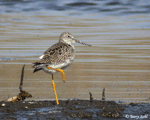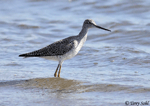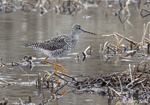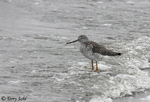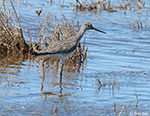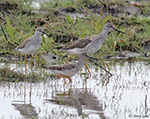| Length: 14 inches | Wingspan: 25 inches | Seasonality: Migrant |
| ID Keys: Compare to Lesser Yellowlegs, longer bill, larger size, harsher call | ||
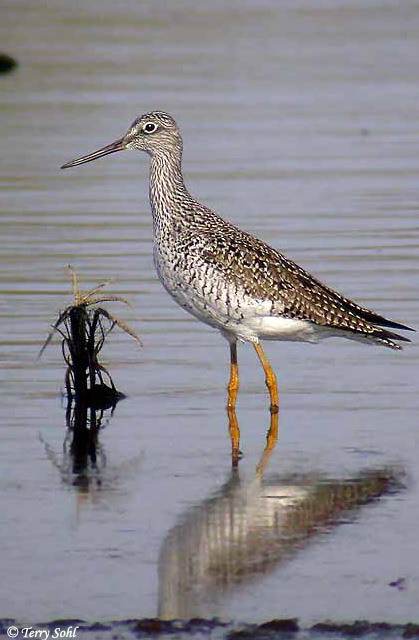 Greater
Yellowlegs are one of the two "Yellowlegs" species migrating through
the state, the other being the Lesser Yellowlegs.
More wary than its smaller cousin, the Greater Yellowlegs will make loud alarm
calls when spooked, with their ringing 3 or 4 note calls a primary means of
differentiating them from Lesser Yellowlegs. In South Dakota, Greater Yellowlegs
are migrants in both the spring and fall. They seem to tolerate cold weather
better than many shorebirds, and are typically one of the first migrating
shorebirds to appear in spring. Unlike many shorebirds, Greater Yellowlegs are
somewhat solitary. While they perhaps will forage in the same general vicinity
as other shorebirds, they're not often found in groups with their own kind in
migration through the state.
Greater
Yellowlegs are one of the two "Yellowlegs" species migrating through
the state, the other being the Lesser Yellowlegs.
More wary than its smaller cousin, the Greater Yellowlegs will make loud alarm
calls when spooked, with their ringing 3 or 4 note calls a primary means of
differentiating them from Lesser Yellowlegs. In South Dakota, Greater Yellowlegs
are migrants in both the spring and fall. They seem to tolerate cold weather
better than many shorebirds, and are typically one of the first migrating
shorebirds to appear in spring. Unlike many shorebirds, Greater Yellowlegs are
somewhat solitary. While they perhaps will forage in the same general vicinity
as other shorebirds, they're not often found in groups with their own kind in
migration through the state.
Habitat:
On their summer breeding grounds, Greater Yellowlegs are found in boggy areas with scattered trees and shrubs, usually nesting near a shallow pond or lake. In migration, they can be found in a very wide variety of wet habitats, including flooded fields, mud flats, shallow ponds, riverbanks, and other shorelines.
Diet:
Greater Yellowlegs primarily feed on insects and other small invertebrates. They will also occasionally feed on small fish, tadpoles, or other small vertebrates.
Behavior:
Greater Yellowlegs primarily forage in shallow water, moving quite actively. They will pluck food items from the surface, or will dip their bills into the water and swing their heads from side-to-side to search for food items.
Breeding:
Non-breeder in South Dakota. On their breeding grounds, Greater Yellowlegs nest on the ground, usually next to a shrub, the base of a small tree, or next to a clump of vegetation. The nest is a simple depression on the ground, lined with leaves, moss, or grasses. The female lays three or four eggs, and both parents help to incubate them. The young hatch after about 22 to 24 days. The young leave the nest as soon as they dry, typically within a few hours. They feed themselves, but are protected by the parents.
Song:
The most commonly heard vocalization is a three or four note, ringing pew-pew-pew as a bird takes flight in alarm.
- Click here to hear the typical flight call of a Greater Yellowlegs1
- Click here to hear alarm calls of a Greater Yellowlegs at a presumed breeding area2
Migration:
Summers in Canada and Alaska. Winters along the U.S. coasts, the extreme southern U.S., and points south. In South Dakota, Greater Yellowlegs are just migrants, in both the spring and the fall. They tolerate the cold weather better than their smaller cousins the Lesser Yellowlegs, and sometimes appear in migration quite early in the spring.
Interactive eBird Map:
Click here to access an interactive eBird map of Greater Yellowlegs sightings
Similar Species:
There's one shorebird species that's a close relative to a Greater Yellowlegs and often causes identification challenges. There are also a few other shorebird species that could potentially be confused with a Greater Yellowlegs.
- Lesser Yellowlegs. There are three primary ways to differentiate Lesser and Greater Yellowlegs, and two of them can be difficult to actually apply in the field! Lesser Yellowlegs are indeed smaller than the Greater Yellowlegs, but unless they're side by side, the size differences can be difficult to judge. The bill is another identifying feature, as Lesser Yellowlegs have shorter, straight bill, while Greater Yellowlegs have a longer bill that typically appears to be slightly upcurved on the outer 1/3rd. However, bill characteristics can also sometimes be difficult to judge in the field. Voice differences are more diagnostic, with Lesser Yellowlegs having a mellower set of call notes that are typically given as single or couble notes. Greater Yellowlegs have a harsher call, higher in pitch, and often given in a series of 3 or 4. For more clues on differences between the two see the Comparison Chart.
- Stilt Sandpiper - Stilt Sandpipers in breeding plumage are easier to differentiate from Greater Yellowlegs, as they have rusty colored patches on their head, some rusty spots on their back, and much heavier barring on their underparts than a Greater Yellowlegs. In non-breeding plumage the two species are more similar, but stilt sandpipers have a noticeably drooping bill, compared to the slight upcurve on a Greater Yellowlegs.
- Solitary Sandpiper - One more sandpiper species with yellow(ish) legs, Solitary Sandpipers are smaller than a Greater Yellowlegs, and the yellow on their legs is more yellowish-green than the bright yellow of a Greater Yellowlegs. Solitary Sandpipers also have a distinctive brown plumage on their upperparts with fine white spots, compared to the more jumbled pattern on the back of a Greater Yellowlegs.
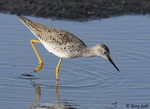 |
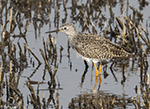 |
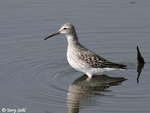 |
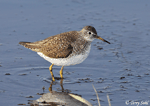 |
| Lesser Yellowlegs | Lesser Yellowlegs | Stilt Sandpiper | Solitary Sandpiper |
Conservation Status:
Systematic surveys in recent decades show no worrisome trends in overall populations. Greater Yellowlegs are still found across a very broad geographic area, and they are common in parts of that range. The IUCN considers the Greater Yellowlegs to be a species of "Least Concern".
Further Information:
Photo Information:
April 22nd, 2003 -- Long Lake near Madison -- Terry L. Sohl
Additional Photos:
Click on the image chips or text links below for additional, higher-resolution Greater Yellowlegs photos.
Audio File Credits:
- 1Sue Riffe. Recorded in Morgan City, Colorado on August 26th, 2020. Original recording and information available from xeno-canto.
- 2Richard E. Webster. Recorded in British Columbia on June 18th, 2014. Original recording and information available from xeno-canto.
| Click on the map below for a higher-resolution view |
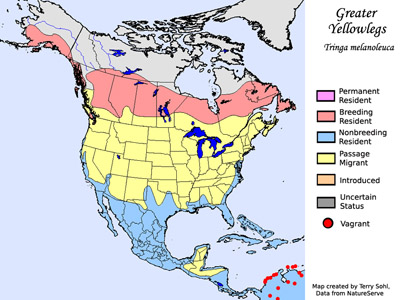 |
| South Dakota Status: Common migrant throughout the state. |
Additional Greater Yellowlegs Photos
Click for a higher-resolution version of these photos
